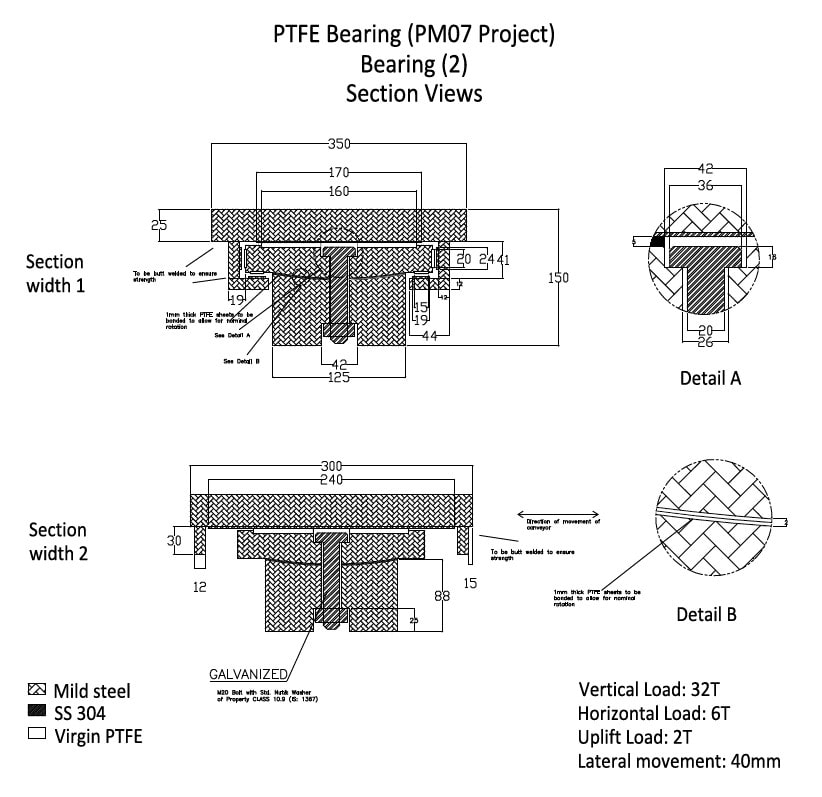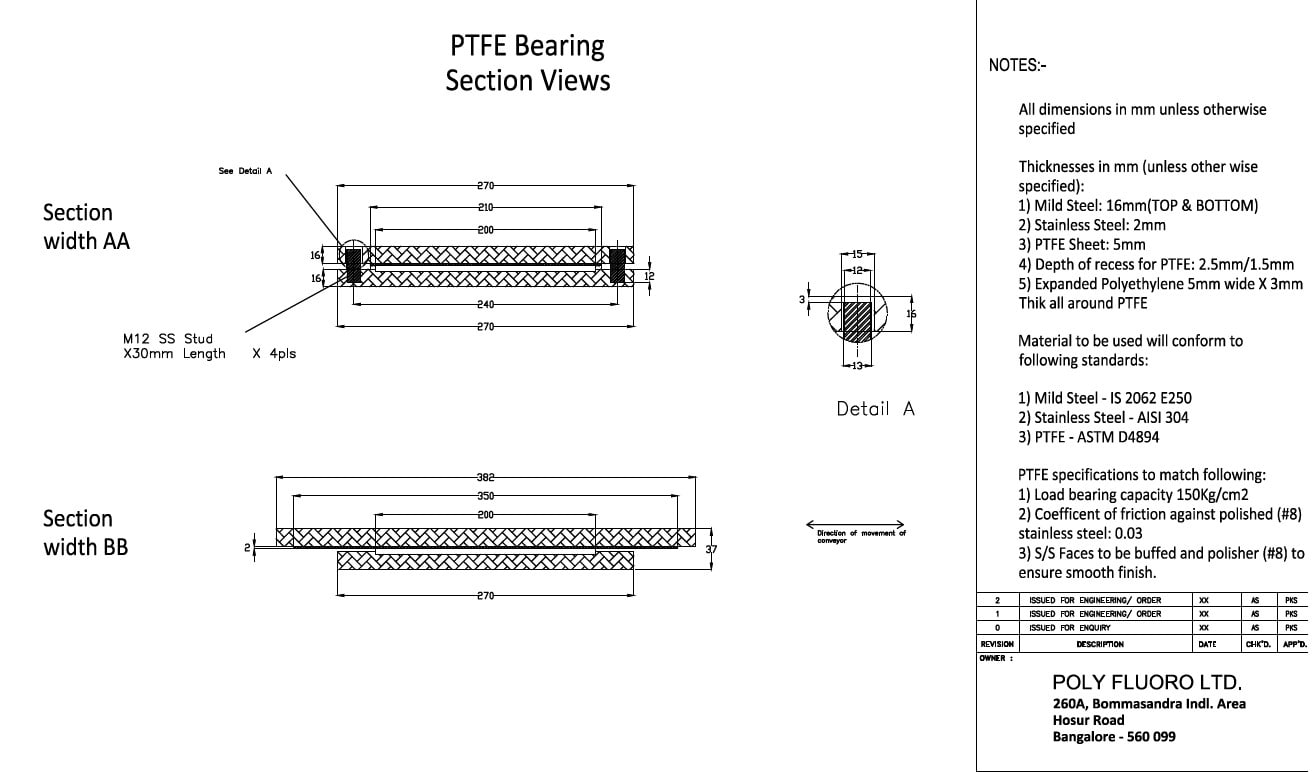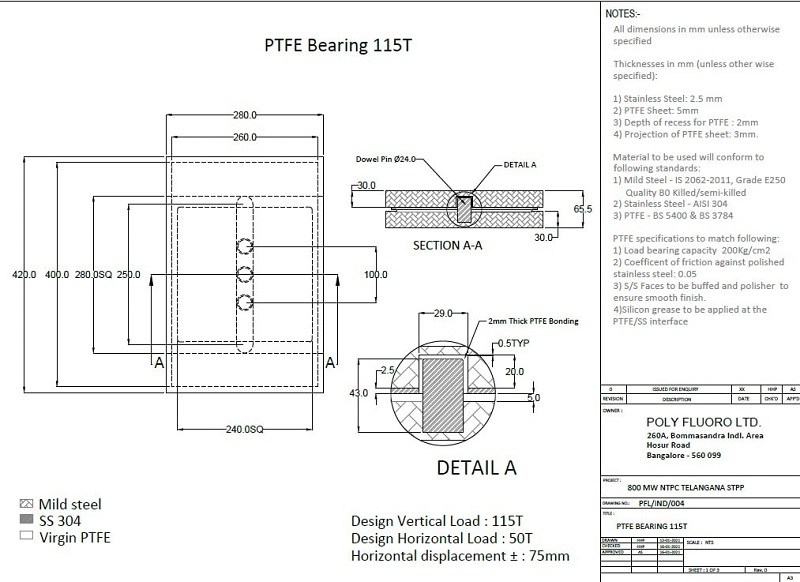Even though PTFE remains a niche polymer among more generic materials such as PP (Polypropylene), PVC, PE (Polyethylenes, such as HDPE and LDPE), and even Nylons, within the engineering space it is now quite common. Most applications involving high temperature, corrosive chemicals, high voltages, or high wear/friction now look to PTFE automatically as a solution.
Despite this, there do exist applications where PTFE does not fit the bill and a compromise must be made. For example, applications where high dimensional stability is needed across a wide temperature range, PTFE tends to fall short. The high linear thermal expansion coefficient of PTFE means that it cannot hold its dimensions as temperatures vary. In our own experience, a PTFE can exhibit linear dimensional changes of up to 3% when the temperature moves from 0 to 100 Deg C.
In such a situation, we have seen PEEK being adopted. While PEEK does do the trick, it is also 10X the cost of PTFE. Similarly, certain applications where cost is a constraint need to make do with POM (Delrin), or even PVC, where PTFE cannot be used. In such a scenario, we possibly forego some of PTFE’s key properties.
Over the years a variety of new polymers have been developed to fill the performance and commercial gaps between PEEK and PTFE. These include PFA, FEP, PEK, PPS (Ryton), and PCTFE.
What is PCTFE?
Although not well known, PCTFE (Polychlorotrifluoroethylene) forms an ideal substitute for PTFE in certain applications where PTFE is unable to perform adequately. The table below is meant to offer a snapshot comparison of the two, such that any application engineer can evaluate the key differences.
|
|
|
Unit |
PTFE |
PCTFE |
Remarks |
|
Properties |
Tensile Strength |
Mpa |
20-30 |
30-35 |
With a marginally higher tensile strength, PCTFE rates higher than PTFE on this metric |
|
Elongation |
% |
200-350 |
100-250 |
PCTFE is stiffer than PTFE, which means it lacks some of the softness of PTFE when it comes to sealing, but that it also holds its dimensions more easily |
|
|
Melting Point |
Deg. C |
350-380 |
200-220 |
PTFE is still preferred on outright high-temperature applications |
|
|
Dielectric Breakdown Voltage |
KV/mm |
50-100 |
20-40 |
PTFE rates higher on outright dielectric strength |
|
|
Coefficient of Friction |
|
0.03-0.05 |
0.25-0.35 |
PTFE rates higher as a non-stick material |
|
|
|
|
|
|
|
|
|
Processing |
Injection Moulding |
|
No |
Yes |
PCTFE has more versatility when processing, allowing for more complex parts |
|
Compression Moulding |
|
Yes |
Yes |
||
|
|
|
|
|
|
|
|
Characteristics |
Chemical Resistance |
|
Extreme |
Very Good |
PTFE is still unmatched in chemical resistance |
|
Thermal Stability |
|
OK |
Very Good |
PCTFE rates higher than PTFE when it is a question of stability over a wide range of temperatures |
|
|
Price |
Med |
High |
PCTFE is more expensive than PTFE, and is therefore used in specific applications only |
As you can see from the above chart, PCTFE and PTFE each have unique advantages and disadvantages when compared with one another. Like all polymers, the application needs to be properly understood and the commercials need to be weighed in before any decision can be made.
In recent times, the enquiries for PCTFE - both as a rod and as a finished component - has increased significantly. With more cryogenic applications (fuelled in no small way by the boom in the medical industry due to COVID), PCTFE is being recognised more and more as an invaluable material for low temperature use.
While the PTFE vs PCTFE debate will always have two sides, it is fair to say that when dimensional stability across a temperature range is a must, PCTFE is growing to become a most effective substitute to PTFE.
Datasheet for PCTFE:
|
Property |
Value |
Units |
Method |
|
MECHANICAL PROPERTIES |
|||
|
Tensile Strength |
4860 - 5710 |
psi |
D 638 |
|
Elongation |
100 - 250 |
% |
D 638 |
|
Flexural Strength, 73°F |
9570 - 10300 |
psi |
|
|
Flex Modulus |
200 – 243 x 103 |
psi |
|
|
Impact Strength, Izod, 23 deg C |
2.5 – 3.5 |
ft-lb/in |
D 256 |
|
Compressive Stress at 1% deformation, |
1570 – 1860 |
psi |
D 695 |
|
Density |
2.10 to 2.17 |
gm/cu.cm |
|
|
THERMAL PROPERTIES |
|||
|
Coefficient of Linear Expansion |
7 x 10-5 |
K-1 |
|
|
Melting Point |
410 -414 |
deg F |
|
|
Thermal Conductivity |
1.45 |
Btu·in/h·ft2·°F |
ASTM C 177 |
|
Specific Heat |
0.22 |
Btu/lb/deg F |
|
|
Heat Distortion Temperature, 66 lb/sq.in (0.455 MPa) |
259 |
deg F |
D 648 |
|
Processing Temperature |
620 |
deg F |
|
|
ELECTRICAL PROPERTIES |
|||
|
Dielectric Strength, short time, 0.004” |
3000 |
Volt/mil |
D 149 |
|
Arc-Resistance |
360 |
sec |
D 495 |
|
Volume Resistivity, @ 50% RH |
2 x 1017 |
ohm-cm |
D 257 |
|
Surface Resistivity, @ 100% RH |
1 x 1015 |
Ohm sq-1 |
D 257 |
|
Dielectric Constant, 1 kHz |
2.6 |
ε |
D150-81 |
|
Dissipation Factor, @ 1 kHz |
0.02 |
D150-81 |
|
|
OTHER PROPERTIES |
|||
|
Water Absorption |
0.00 |
% increase in weight |
D570-81 |
|
Flame Rating+ |
Non-flammable |
D 635 |
|
|
Coefficient of friction (Dynamic) |
0.25-0.35 |
D 1894 |
|
|
Specific Gravity |
2.10 to 2.17 |
D792 |
|
|
Moisture Permeability Constant |
0.2 |
g/m, 24 hours |
|
|
O2 Permeability |
1.5 x 10-10 |
Cc, cm/sq.cm, sec, atm |
|
|
N2 Permeability |
0.18 x 10-10 |
Cc, cm/sq.cm, sec, atm |
|
|
CO2 Permeability |
2.9 x 10-10 |
Cc, cm/sq.cm, sec, atm |
|
|
H2 Permeability |
56.4 x 10-10 |
Cc, cm/sq.cm, sec, atm |
|






